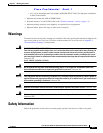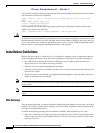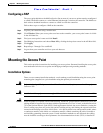
Cisco Confidential - Draft 1
2-7
Cisco Aironet 1500 Series Outdoor Mesh Access Point Hardware Installation Guide
OL-9977-05
Chapter 2 Mounting Instructions
Installation Guidelines
• Antenna type and placement—Proper antenna configuration is a critical factor in maximizing radio
range. As a general rule, range increases in proportion to antenna height. However, do not place the
antenna higher than necessary, because the extra height also increases potential interference from
other unlicensed radio systems and decreases the wireless coverage from the ground.
• Physical environment—Clear or open areas provide better radio range than closed or filled areas.
• Obstructions—Physical obstructions such as buildings, trees, or hills can hinder performance of
wireless devices. Avoid locating the devices in a location where there is an obstruction between the
sending and receiving antennas.
Before Beginning the Installation
Before you begin the installation process:
• Ensure that a site survey has been performed.
• Ensure that your network infrastructure devices are operational and properly configured.
• Ensure that your controllers are connected to switch trunk ports.
• Ensure that your switch is configured with untagged access ports for connecting your access points.
• Ensure that a DHCP server with Option 43 configured is reachable by your access points or
manually configure the controller information in the access point (for additional information, refer
to the “Configuring DHCP Option 43” section on page G-1).
• Become familiar with the access point installation components (see the “Becoming Familiar with
Access Point Installation Components” section on page 2-7).
• Add the MAC addresses of the access points to the controller’s filter list (see the “Adding the Access
Point MAC Addresses to the Controller Filter List” section on page 2-10).
• Enable automatic configuration of access points on the controller (see the “Enabling Zero Touch
Configuration on the Controller” section on page 2-10).
Becoming Familiar with Access Point Installation Components
The access point is designed to be installed in an indoor or outdoor environment, such as an interior wall
or ceiling or the exterior roof overhang of a tall building or a streetlight pole.
Note When you mount access point in an indoor environment, you must also mount the attached antennas in
an indoor environment.
Carefully review the following figures to become familiar with the system components, connectors,
indicators, cables, system interconnection, and grounding:
• Components in a Typical Access Point Installation (Figure 2-1)
• Access point connectors (Figure 2-2)
• Streetlight power tap installation (Figure 2-3)


















